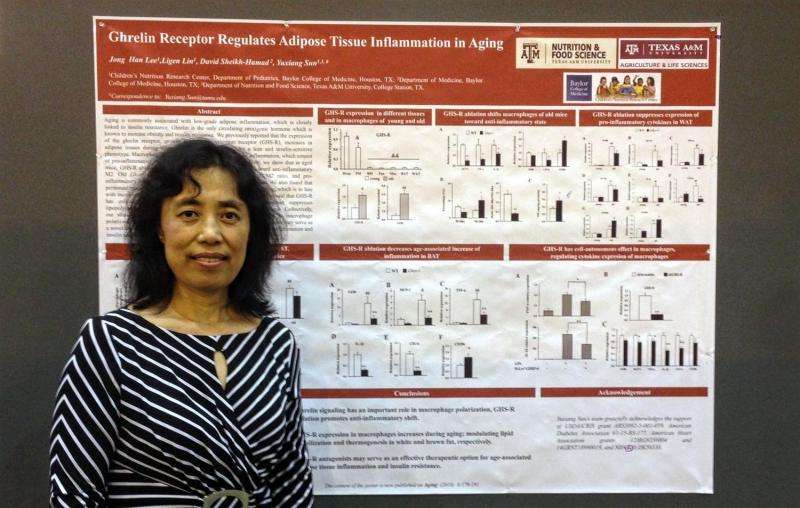Study examines role of ghrelin receptor in fat tissue inflammation and insulin resistance

Scientists have proposed that inflammation is the harbinger of aging and central to the aging process, a phenomenon described as 'inflamm-aging,' said Dr. Yuxiang Sun.
Sun, a faculty member in the department of nutrition and food science at Texas A&M University in College Station, said aging is commonly associated with low‐grade adipose inflammation, which is closely linked to insulin resistance, a condition often leading to type 2 diabetes.
In research recently published in the premier science journal Aging, Sun and colleagues investigated the role of the ghrelin receptor, growth hormone secretagogue receptor, or GHS‐R, in age‐associated adipose tissue inflammation and insulin resistance in mice.
"Ghrelin is a ligand, a molecule that binds to a specific receptor to transduce specific kind of signal" she explained. "GHS-R is the receptor of ghrelin, for which it has a binding pocket for ghrelin. Ghrelin and GHS-R work like a key and a lock."
She said hunger stimulates the ghrelin section in the gut, which activates brain regions where GHS-R is highly expressed, triggering the hunger sensation. Ghrelin enhances appetite and increases weight gain, promoting obesity and insulin resistance.
"To date, ghrelin is the only known orexigenic or appetite-stimulating hormone," she said. "The pharmaceutical industry has been calling ghrelin 'the key to obesity' since its discovery. We investigated the impact of ghrelin signaling on adipose tissue macrophages, in order to understand the role of ghrelin signaling in obesity."
Sun said obesity, in essence, is a low-grade chronic inflammation in adipose tissues. Adipose tissue serves as a major endocrine organ, secreting various hormones and cytokines which play crucial roles in normal metabolism and obesity-associated dysfunctions.
"There are 2 types of adipose tissues: white and brown adipose tissues," Sun said. "While the hallmark function of white adipose tissue is to store excess lipids in the body and supply free fatty acids as energy as needed, the symbolic function of brown adipose tissue is to break down lipids to generate heat, which burns fat."
Adipose tissue macrophages, or ATMs, are a major mediator of inflammation in adipose tissues, which are closely linked to insulin resistance, she explained. Macrophages are a type of white blood cells that surround and digest microbes, pathogens and other foreign substances.
Sun said recent literature suggests macrophages play central roles in inflammation/immune responses as well as the stress response.
"Macrophages are a major mediator of inflammation in the body," she said. "Increased macrophage infiltration in adipose tissues has been shown to positively correlate with age-associated metabolic complications, neurodegenerative diseases and cardiovascular diseases."
Sun said ATMs consist of two subsets –pro-inflammatory M1 and anti-inflammatory M2. M1-like macrophages are associated with an obese and insulin-resistant state, while M2-like macrophages are associated with a lean and insulin-sensitive state. M1-like macrophages release pro-inflammatory cytokines to inhibit insulin action in the tissues, she said. On the other hand, M2-like macrophages release anti-inflammatory cytokines.
New findings indicate M2-like macrophages also release the 'fight or flight' response hormone norepinephrine, promoting lipid mobilization in white adipose tissue and thermogenesis, or heat production, in brown adipose tissue, Sun noted.
"We have found that the GHS-R functions as a key regulator of age-associated adipose tissue inflammation in both white and brown adipose tissues," she said. "The removal of GHS-R shifts macrophages toward an anti-inflammatory state and leads to higher norepinephrine production in the macrophages."

Sun also noted aging is commonly accompanied by increased fat mass and chronic low-grade inflammation, so concurrences of obesity and insulin resistance become significantly greater as people get older.
"Epidemiological studies show that the prevalence of insulin resistance and type 2 diabetes is clearly higher in the elderly," she said.
Sun said little is known about the genes that regulate ATMs and adipose tissue inflammation during aging, and information in regard to the role of M2 macrophages in adipose tissues is even scarcer.
"Identification of factors regulating macrophage infiltration in adipose tissues and controlling macrophage polarization are important questions in obesity and aging research," she said.
Her study, GHS-R global null mice—with the GHS-R removed in all cell types—showed a macrophage profile shifted toward the anti-inflammatory M2, exhibiting a healthier lean and insulin-sensitive phenotype.
"Old mice with GHS-R deletion showed a reduction in macrophage infiltration, M1/M2 ratio and pro‐inflammatory cytokine production in both white and brown adipose tissues," she said.
Sun said there is a clear correlation between adipose inflammation and the incidences of insulin resistance and type 2 diabetes during aging.
"Our study shows macrophage numbers and pro-inflammatory cytokine expression in white adipose tissue increase with aging," she said. "We found that removal of GHS-R prevents age-associated obesity and insulin resistance, at least in part, through increased heat production in brown adipose tissue. And the ATMs from the aged GHS-R global null mice produce higher norepinephrine, which is line with our observation that the null mice have reduced fat mass in white adipose tissue and increased thermogenic activation in brown adipose tissue."
She said the new findings suggest suppressing the ghrelin receptor may serve as new therapeutic strategy for inflammation and obesity in aging.
The study clearly indicates the ghrelin receptor plays an important role in macrophages, which can have profound implications on obesity and insulin resistance, she said.
"GHS-R antagonists may serve as a unique class of anti-obesity drugs that can prevent or treat age-associated obesity and insulin resistance by simultaneously suppressing adipose tissue inflammation, promoting lipid mobilization in white adipose tissue and stimulating the heat production in brown adipose tissues."
She said, put simply, GHS-R antagonists likely to have dual effects of breaking down fat and burning more fat.
"I believe suppressing the ghrelin receptor in macrophages has enormous therapeutic potential," she said. "It would not only have beneficial effects on inflammation, but also can improve whole body metabolism in aging."
However, she cautioned, her current research using global null mice cannot determine whether the phenotype is resulted in by the effect of GHS-R in macrophages alone. Scientists must determine the macrophage-specific effects of GHS-R and understand precisely how ghrelin signaling works, in order to avoid unintended side effects. Her laboratory now is developing new mouse models which would enable them to delete GHS-R selectively in macrophages.
More information: Ghrelin receptor regulates adipose tissue inflammation in aging. Aging, DOI: 10.18632/aging.100888
















